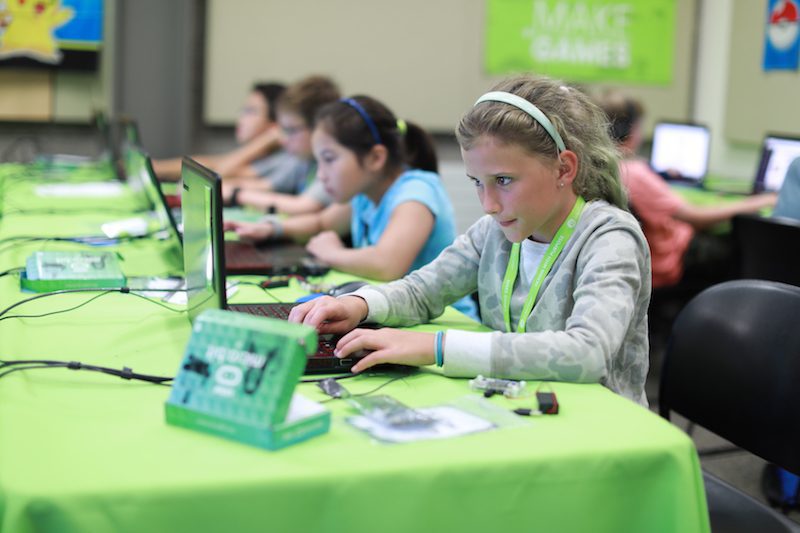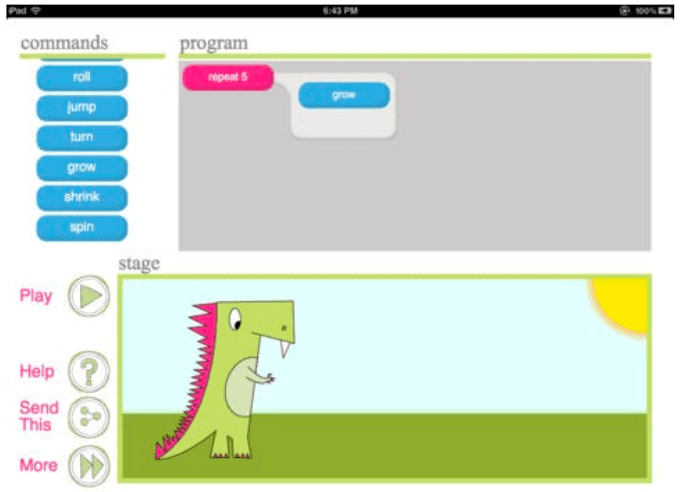You’ve probably heard that learning a new language is easier for children—and it’s true! Kids are still developing their brains and forming neural pathways, making it easier to absorb information.
When most people talk about kids learning languages, they’re thinking about French, Spanish, German, etc.—not programming languages like HTML and CSS. But in this modern world, coding for kids is just as important and impactful as growing up bilingual or trilingual!
So, what is coding for kids and how can you get them started? In this guest post, Burkhard Berger explains the importance of coding with kids and great beginner coding languages for them. He also suggests a variety of paid and free coding-for-kids resources.
Here’s Burkhard!
Table of Contents
- Why Should Your Child Learn How to Code?
- What Is Coding for Kids? 3 Beginner Languages for Children
- Where to Start Coding with Kids
- Start Coding With Your Kids Today
Why Should Your Child Learn How to Code?
Coding is increasingly becoming one of the most important skills to have if you want a high paying job in the future. According to a report from Burning Glass, there were seven million job openings in 2015 for occupations that required coding as a skill. The same report brought to light that programming jobs are growing 12% faster than the average market rate.
Programming jobs also allow people the opportunity to make money online and have a more flexible work schedule. It is one of the few jobs that also give you the ability to take on multiple clients at the same time and manage your own work projects.
For most parents, these reasons alone are enough for them to realize that coding with kids will undoubtedly give their children a leg up.

However, if you are looking for more benefits of coding for kids, here are a few worth mentioning:
- 💻 Computational skills – Coding helps kids solve real, complex problems that go beyond the walls of their classroom. Picking up on these computational skills is one of the most noticeable benefits parents see in their children. This is because coding allows children to solve problems that can be broken down into parts and solved step by step.
- 🎨 Creativity – The countless coding solutions and variations allow children to really use their imaginative minds to the maximum. In the long run, this also helps children express themselves creatively.
- ❌ Coding helps kids avoid errors – The right line of code is responsible for an application working, while the wrong line of code can crash it. This is something that will help teach children how to bypass problems and find a solution.
- 🤓 Structural thinking – Much like a story, coding also has a beginning, a middle, and an end. Coding allows children to learn how to build something big using a bunch of smaller parts to get there. It is one of the few skills that teach children how to view a problem not as one impossible obstacle but rather as many small parts that should be dealt with separately. This means they are less likely to become overwhelmed by bigger problems.

In the long run, coding is going to become an indispensable skill to have which means anyone who excels at it has a good chance of becoming indispensable himself. Even in the short term, you will see an improvement in academic performance and your child’s overall growth since coding really allows a child to reach their potential.
Think of coding much as you would think of learning a new instrument. It takes hours of practice, years of hard work, and plenty of guidance but the sooner you start, the better. Kids as young as six years old can start to learn the basics of coding with the help of immersive apps, online classes, or in-person courses. We will cover a few of the best options for each of these next.
Start coding now
Stop waiting and start learning! Get my 10 tips on teaching yourself how to code.
Head back to the table of contents »
What Is Coding for Kids? 3 Beginner Languages for Children
Most parents are of the opinion that coding can only be learned by adults and would be an impossible task for children. However, what you need to understand is that the lines of code that you see when you Google the word “coding” is not what your child will be starting off with. They’ll work up to those complex languages over time.
That brings us to the question: what is the best coding language for kids? There are many options, but here are a few good ones to consider if your child is just beginning.
Scratch 3.0

Scratch is a block-based programming language that is most suitable for children over the age of eight. It was created by Mitch Resnik at the Massachusetts Institute of Technology (MIT). The software has been translated to over 70 different languages and can be used by children to create mini-projects using blocks.
The visual blocks make it a great coding option for kids since it eliminates the annoying lines of code that can scare away even teens. Learning to code becomes simple and it is a good first step for any child because it gives them the confidence to move on to the second.
The child walks away feeling like they were the true designers of the game or project they created, which can be exhilarating. Another cool feature is that you store your saved work onto the Scratch server which allows other users to see it and learn from them.
Head back to the table of contents »
Blockly

Blockly is another visual programming language, which is why it is suitable for coding with kids. It was created by Google and is an open-source software free for anyone to use. It is a visual code editor that can be added to web and mobile apps. So, instead of actual code concepts like loops or variables, Blockly will use blocks to showcase these elements.
It is often considered to be a client-side library for the JavaScript programming language. A good way to think of Blockly is to look at it as a language created out of multiple other programming languages. It can also be described as a superset of languages because of this feature. It is often considered to be Google’s response to Scratch since the two share so many similarities.
The software works by stacking blocks together to form the code, which can later be translated into actual textual code. Despite being very child-friendly, Blockly can also be used to create mathematical equations and other more complex code which is why it can teach coding for kids up to the age of 16.
Head back to the table of contents »
Lua
Lastly, Lua is the only text-based programming language on this list. It is considered to be a good language to use when you are first coding with kids and introducing them to text-based code.
Lua is a free coding language known for its speed and simplicity. It is often used to create apps and games on Android and iOS devices. You can see what Lua programs look like with this live demo.
Head back to the table of contents »
Where to Start Coding with Kids

If your children are just about to take their first coding class, it is important that you take a few minutes to actually prepare them so they know what to expect. You can do this by explaining exactly what coding is and going through a few of the most common languages they can expect to encounter.
You could do this by explaining what different languages do, using real-life examples to help them understand better. So, for example, you could take your child to a website and explain to them how JavaScript is a language that helps build web pages. This could be a great way to introduce a child to the concept of coding before moving on to the next step, which is actually teaching them how to code.
There are multiple options to teach your child how to code and we are going to cover some of my personal favorites. This will include in-person courses, online programs, and even app-based learning. If your child is already in their teens, you could even consider introducing them to a podcast that teaches people how to code and how to build a career in technology.
Learn to Code With Me has one of the most informative coding podcasts which is a good place to start.
Want to get better with HTML?
Download my free HTML5 cheat sheet below.
Head back to the table of contents »
In-person coding courses & programs for children
The best way to find in-person coding for kids is to explore your local learning centers, groups, options at school, etc. However, here are three in-person coding summer camps with options around the world:
- Code Apps With Java – This course will teach children aged 13 to 17 the fundamentals of Java. The course will teach children how to code projects in Java; how to use loops, arrays, and if statements; and how to identify variables, data types, and classes. There are a few global locations and multiple options across the United States.
- Code Apps With C++ – This camp will teach teens (13 to 17) the fundamentals of C++. It is one of the more difficult coding languages and can be used to develop games or design system software. The course teaches students how to read and respond to user input; work with characters, strings, and algorithms; and solve programming challenges.
- Intro to Python Coding – The Intro to Python course is a higher-leveled course that is suitable for children who have already taken a few coding courses in the past. This Python coding class for machine learning will cover basic neural networks, computational thinking skills, and preparing for more advanced machine learning.
Head back to the table of contents »
Online coding courses for kids
If you are looking for a more flexible and affordable option, online courses and platforms are a great idea. Kids can learn to code at home on a flexible schedule in a way that feels more like a game than like another piece of homework.

There are thousands of coding-for-kids options to choose from, so the only difficulty is finding one worth investing in. Here are some of my favorites:
Please note that information below may change in the future!
Free coding for kids online
- Code.org – Code.org is one of the most famous free coding school options with over 50 million students that have already used the platform to learn new skills. The lesson plans and programming steps make it easy for children to learn the basics of coding in a well-formatted manner.
- Code Monster – Code Monster is a very simple tool that helps kids get excited about programming by letting them experiment with code using a combination of tutorials and games.
- Scratch – The same language we mentioned earlier also has a range of tutorials and projects on their website that allow children to test and learn more about the software online for free.
Paid coding programs for kids

- Code Monkey – Code Monkey is a game-based coding program that teaches kids with the help of courses, online challenges, video tutorials, engaging activities, and free webinars. The monthly subscription plans start at a very affordable $4.95.
- CodeCombat – Code Combat also uses coding games to teach children Python and JavaScript. It is extremely interactive and is known to be one of the most loved coding games available. At present, they are even running a global ‘CodeQuest’ throughout the month of August. This option is free to play for all of the core levels, after which there is a $9.99 subscription cost per month for access to extra level branches.
- Codemoji – Codemoji was designed with schools in mind and has a curriculum especially suited for students between the 1st-8th grade. The curriculum helps students learn the basics of coding, which includes topics like CSS and Javascript. They follow a similar pattern of teaching through doing, so a lot of their curriculum involves creating websites and animations with the help of tutorials. This has been pretty popular among kids in schools.
- Kids Coding – Introduction to HTML, CSS and JavaScript – This course from Mammoth Interactive teaches kids how to code in HTML, CSS, and JavaScript. It adapts the material to their learning styles using animated lectures and informative screencasts.
Coding apps

- Daisy the Dinosaur – The great thing about coding apps is that they can be used for basic coding with kids of pretty much any age. This free app features a drag-and-drop interface that can be used by children to make Daisy the Dinosaur dance on their screen.
- Tynker – Tynker is used by over 60 million children to learn how to code online with the help of a well-formatted curriculum that involves tons of tutorials. The app teaches coding for kids by guiding them through tasks like building apps, programming drones, and modifying Minecraft. Since things like drones and Minecraft are already popular with children, the app teaches coding basics for kids in a fun way. Their tablet plan is $11.99 per month or $95.99 per year.
- Kodable – Lastly, Kodable is an app that is suitable for kids between the ages of 4-10. The app uses fun activities, challenges, and lessons to teach kids concepts like sequence, syntax, variables, properties, and more. It is used by over 50% of U.S Elementary schools.
Head back to the table of contents »
Start Coding With Your Kids Today
With millions of jobs predicted to be stolen by AI in the coming years, coding seems to be one of the few that will get by unscathed. If you do choose to invest in your child’s coding education, there is a good chance they’ll thank you for it one day.
Even if your child does not get into the world of tech, the benefits of learning coding in daily life cannot be ignored. Steve Jobs summed it up well when he once said,
💡 “Everybody in the country should learn how to run a computer because it teaches you how to think.”
Do you support teaching coding for kids? Share this with a friend that might find it useful.
Author Bio

Burkhard Berger is the founder of awesomex™. You can follow him on his path from 0 to 100,000 monthly visitors on www.awesomex.com. His articles include some of the best growth hacking strategies and digital scaling tactics that he has learned from his own successes and failures.
Feel free to follow him on Instagram, Facebook, and Twitter.

